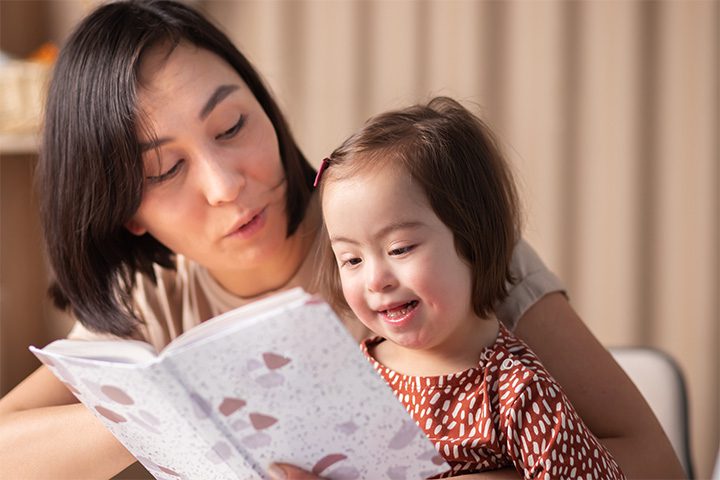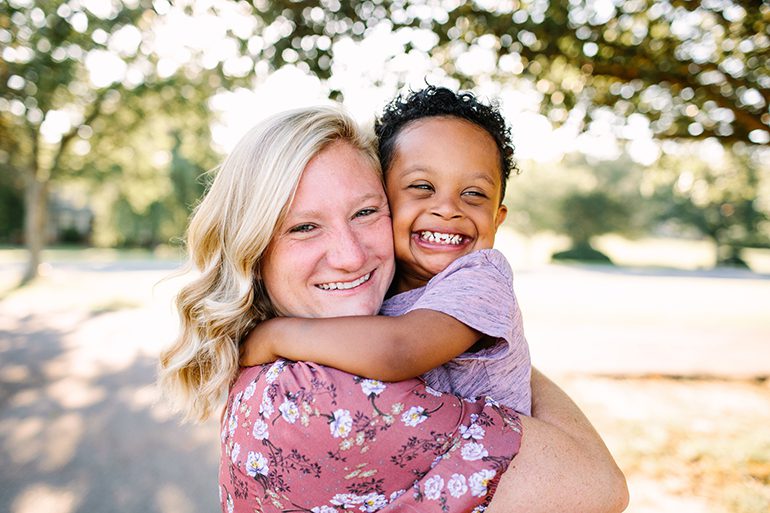Within our organization at DownSyndrome Achieves, some of us have children with Down syndrome. And we know how crucial it is to educate yourself about a Down syndrome diagnosis.
To help your child live the fullest quality of life possible, it’s crucial to understand how health conditions associated with these different types of Down syndrome can impact them. Read on to discover more about the different types of Down syndrome and questions to ask your healthcare provider.
What is Down syndrome?
Down syndrome is a genetic condition found in about one in 700 babies born in the U.S. A person is diagnosed when an extra chromosome is detected in their cells. The test used to diagnose this is called a karyotype. If a person’s karyotype reveals 47 chromosomes, they are diagnosed with Down syndrome. The average person has 46 chromosomes.
There are three different types of Down syndrome that can cause intellectual developmental delays and physical challenges for a child with DS.
It’s essential for parents to understand the facts about Down syndrome and be informed about important resources and support groups they can utilize.
Should I have a screening test for Down syndrome during pregnancy?
It’s up to the expectant mother whether or not she wants to get a prenatal screening test. A woman of any age and pregnant can have a baby with Down syndrome. Down syndrome is not a genetic trait that is passed on. There are several reasons why she may want to consider getting a prenatal screening test, which can indicate whether there’s a high or low chance of the baby having Down syndrome. These reasons could include:
- Wanting as much information as possible about the baby before giving birth
- Being 35 or older (at higher risk) and wanting to confirm if the child shows any markers for Down syndrome
- Wanting to test for other more serious life-threatening conditions like trisomy 18 and trisomy 13
What causes Down syndrome?
Down syndrome occurs when nondisjunction occurs. Nondisjunction is an error of cell division that occurs during conception. Instead of only two copies of chromosome 21 in the embryo, there are three. As the embryo continues to develop week to week, this extra chromosome is replicated in the different cells of the baby.
It is not known why this occurs.
How many different types of Down syndrome are there?
There are three different types of Down syndrome a child can be diagnosed with. The different Down syndrome types are:
- Trisomy 21 (Nondisjunction)
- Translocation Down syndrome
- Mosaic Down syndrome
Trisomy 21 (Nondisjunction)
Translocation Down syndrome is one of the three forms of Down syndrome in which a whole or part of the 21st chromosome is attached to another chromosome. The third copy, often seen in T21, is not presented as a set of three individual chromosomes. It’s the genetic material from this extra copy of the 21 chromosomes attached to a chromosome that causes health problems in people with Down syndrome. People with Translocation Down syndrome often have the same symptoms as people with T21 Down syndrome. Translocation Down syndrome happens in around 3% of Down syndrome cases in babies.
Physical characteristics of baby with trisomy 21
Babies born with trisomy 21, may have certain physical features associated with the condition. These features could include:
- An overall short and stockier build
- Shorter neck
- Brushfield spots (white spots) on the iris of the eye
- Rounder face that tends to be flatter
- The mouth, nose, and ears are all a little bit smaller
- Eyes may appear more almond-shaped
- 5th pinky finger may be slightly bent
- The tongue may protrude out a little more
- Palmers crease
- Sandal gap between their big and second toe
Translocation Down Syndrome
Translocation Down syndrome is one of the three forms of Down syndrome in which a whole or part of the 21st chromosome is attached to another chromosome. The third copy, often seen in T21, is not presented as a set of three individual chromosomes.
It’s the genetic material from this extra copy of the 21 chromosomes attached to a chromosome that causes health problems in people with Down syndrome. People with Translocation Down syndrome often have the same symptoms as people with T21 Down syndrome.
Translocation Down syndrome happens in around 3% of Down syndrome cases in babies.
Parents with balanced translocation
If children are diagnosed with translocation Down syndrome, the DNA of the parents is looked at to understand if translocation was inherited. If it has been inherited, the parent will have 45 total chromosomes in each cell of the body. The parent will not have any physical signs of having Down syndrome. Another thing to note is that the parents’ siblings may also have inherited this genetic condition.
Translocation Down syndrome Pregnancy
Parents with balanced translocation may experience different things throughout the pregnancy. It’s not uncommon for a couple to experience more trouble getting pregnant. They may also experience many miscarriages and have an increased risk of having a child with health problems due to this rearrangement of chromosomes.
Mosaic Down Syndrome
Mosaic Down syndrome is one of the least common forms of Down syndrome., About 2% or less of people diagnosed with Down syndrome have Mosaic. This type of Down syndrome occurs when not all but only some cells in the body have an extra copy of chromosome 21. It’s an event in the body that happens shortly after conception when the egg from a female and sperm from a male are joined.
Mosaicism
Mosaicism is another term for mosaic Down syndrome. Those with Mosaic Down syndrome can share many of the similar health problems you would see with other people who have trisomy 21 or translocation Down syndrome.
Physical characteristics of baby with mosaic Down syndrome
Babies with Mosaic Down syndrome may have similar features as those with trisomy 21 listed above OR they may have fewer features because only some cells have three copies of chromosome 21. The more cells in the body with only two copies of chromosome 21, the fewer physical features you can see in your baby that resemble children with DS.

Helpful Questions to Ask Your Healthcare Provider
If you find out through prenatal screening that your baby has an increased chance of having Down syndrome, or you find out your baby has Down syndrome at birth, you may consider asking your healthcare provider some of the questions below:
- How can I best prepare for the birth of my child knowing he/she may have Down syndrome?
- How do I find out about local Down syndrome specialty clinics near me?
- What support groups and Down syndrome resources should I be aware of?
- Who do I need to ensure is on my child’s healthcare team?
FAQs Related to the Different Types of Down Syndrome
What is the most common form of Down syndrome?
Trisomy 21 is the most common of the three different types of Down syndrome. This is the diagnosis for individuals with Down syndrome that happens in all but 5% of DS cases.
What is the mildest or rarest form of Down syndrome?
Because Mosaic Down syndrome means a child has a mixture of cells with the typical two copies of chromosome 21 and some with three copies, these children have fewer symptoms of Down syndrome. This is often the case for the 2% diagnosed with mosaicism, but not always.
What is the difference between trisomy 21 and mosaic Down syndrome?
Of the three different types of Down syndrome, trisomy 21 is the most common (around 95%), and mosaic Down syndrome is the least common (around 2%). While those with trisomy 21 have a greater chance of having lower IQs, those with mosaic Down syndrome tend to have higher IQs when tested. All those with Down syndrome can experience different health conditions related to sleep disorders, immune disorders, hearing issues, heart defects, and visual impairments.
